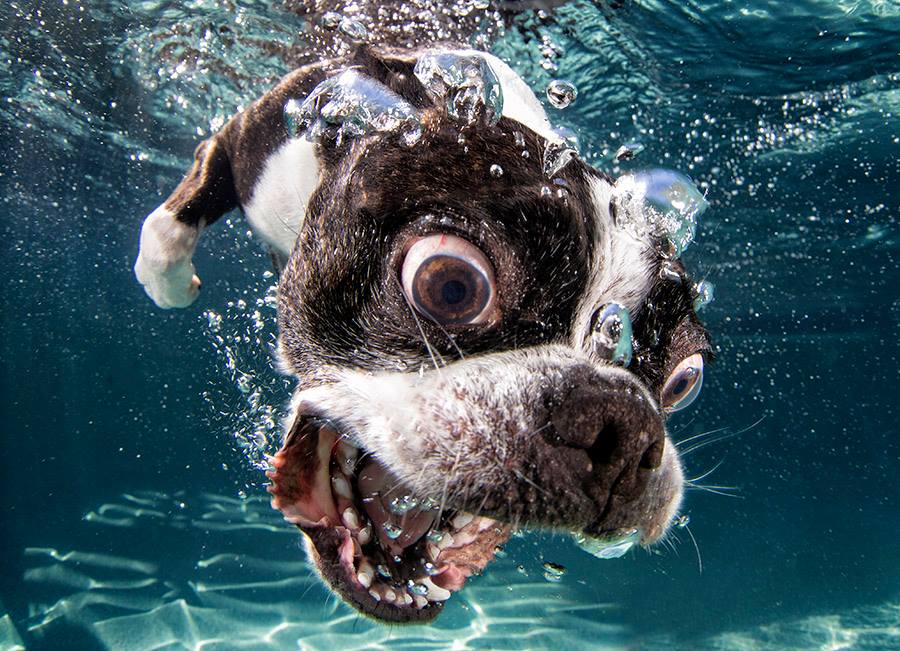
Swimming, most of us think that all dogs are natural swimmers and something that they are born with but that’s not always the case. Here is how to gauge your dog’s swimming skills safely and teach him the basics. The younger your dog is when you do this the better.
As with other things in life keep the lesson positive and stress-free!- Choose a quiet, shallow spot in the water.
- Keep your dog on a leash while he’s learning.
- Get in the water with him.
- Start at the edge of the water and stay as long as he enjoys it.
- Don’t force him into water -- especially a deep spot -- if he doesn’t want to go. “Sink or Swim” is NOT how we teach!
When your dog begins to paddle with his front legs, lift his hind legs to show him how to float.
IN THE POOL
Many lucky people have a pool and want to share it with their dog. Here are some tips on how to keep it safe for your dog!
As with kids, put a fence around the pool to keep your dog out when it’s not time to swim.
- Keep a sturdy cover over the pool when you're not using it. It should be made of a material that lets rainwater drain through. Dogs can drown in puddles on top of pool covers.
- Teach your dog how to get out of the pool. Make sure there are steps or a ramp he can use to climb out.
- Check the water temperature before letting him take a dip. Only a few breeds can handle extra cold water.
As convenient the pool can appear to be, pool water can dry out your dog's skin. Many dog owners find that itching increases after their dog swims. In addition, the calcium hypochlorite/chlorine (used to keep pools clean) can sometimes turn dogs with white hair coats “green”. Here are some tips to keep your dog's skin moisturized so he can still enjoy the pool!
- Rinse with plain water at end of swim day
- Remove any water from the ears that can lead to ear infections. Consider using Swimmer's ear drops (used in people & available at the drugstore)
- Add a fatty acid supplement to help increase moisture to the skin & hair coat
AT THE BEACH
Dogs often love playing in the surf! Keep these tips in mind when taking your dog to the beach.
- Watch out for strong currents and rip tides, which can take you both out to sea. Even the best swimmer can be in danger when the seas are rough.
- Don’t let your dog drink ocean water (or any type of salt water any time!). It can make him sick. Be sure to bring fresh water for you both any time you pursue outdoor activities. It’s important to stay hydrates.
- Although this can be challenging, keep your dog away from fish, crabs, jellyfish or other dead creatures that have washed ashore. They may smell great to him (dogs often love rolling around on top of dead fish!) but can make him ill… and STINKY!
IN A RIVER, LAKE OR POND
In general, safety tips that apply to kids apply to dogs. Get your dog a life jacket to wear when you take him out on a boat or dock.
- Do not allow your dog to swim in bodies of water with blue-green algae. Dogs can become sick if the algae penetrates the skin (through a cut or open wound) or if they ingest contaminated water.
- Check the current and make sure it’s not too strong to let your dog swim in the river or creek.
- Keep your dog AWAY from FISHING GEAR! Sharp hooks an barbs can hurt him and require a trip to an emergency hospital to remove!
GENERAL WATER SAFETY TIPS- FINAL REVIEW!
- Make sure your dog can swim! Not all dogs are natural swimmers (my own Golden Retriever is an example!) so test your dog in shallow water & on a leash first.
- Steer clear of bodies of water with blue-green algae! It can make your dog sick if these organisms enter the skin or mouth.
- Rinse off after being in any type of water, if possible bathing is preferred- salt, seawater minerals, chlorine & pollution can irritate skin (especially dogs with allergies & sensitive skin).Unleash your dog’s healthy skin by using Canine Skin Solutions products!
- Dry your dog's ears completely after swimming. This may involve using swimmer's eardrops to help remove water trapped in the ear canals.
- Get your dog a life jacket- especially if they spend time on a boat or dock.
- Never leave your dog alone in the water- learn canine CPR, mouth to nose resuscitation can safe your dog's life!
Source: Canine Skin Solutions Inc.
4244 Madison Avenue, Trumbull, CT 06611
© 2016-2022 Wet Paws Dog Grooming, LLC. All rights reserved.




